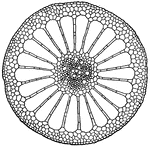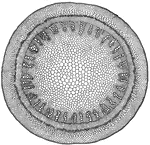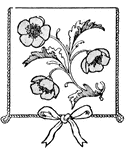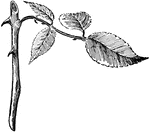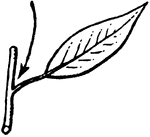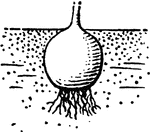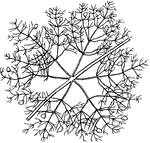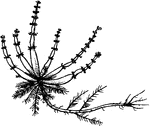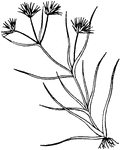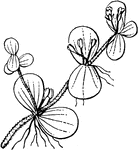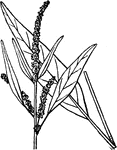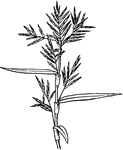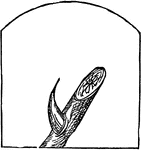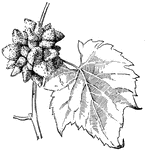
Gall
Galls on stem of grape. The location of a parasite is often marked by swellings of peculiar and fantastic…

Dandelion Seeds
Each seed has a very little stem. This stem has on its end some very fine fibres standing out all around.…
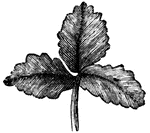
Leaf
Leaves are arranged in a great many different ways on their stems. Here are three leaves together on…

Leaf
Leaves are arranged in a great many different ways on their stems. Here the leaf-stem has three little…
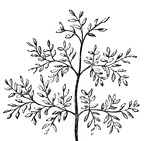
Leaf
Leaves are arranged in a great many different ways on their stems. On this leaf-stem are a great many…
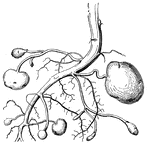
Potato Root
This shows real roots of the potato, as well as several branches of the stem, with potatoes forming…
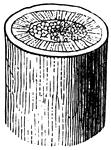
Woody Stem
The central part of the stem is the pith, then is the cellular tissue and finally the bark.
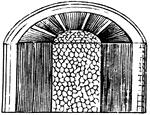
Woody Stem
The central part of the stem is the pith, then is the cellular tissue and finally the bark.

Poisonous Hemlock
Hemlock is a genus of poisonous plants. It has a tall, hollow stem and white flowers.
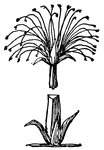
Papyrus
The papyprus is a frequent form in Egyptian ornament. Its straight, stiff triangular stem with four…

Rinceau
A band design that includes a round stem, springing from a nest of acanthus leaves, then branching into…

Antic
Antics are fancies having no foundation in nature, as sphinx, centaurs, etc., different flowers growing…
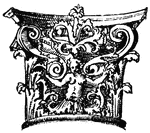
Antic
Antics are fancies having no foundation in nature, as sphinx, centaurs, etc., different flowers growing…
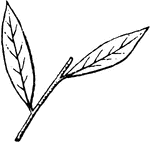
Alternate
Usually pertains to leaves. Not opposite each other but bourne singly at different levels on the stem.

Decurrent
Extending or running down on another structure, as a leaf on a stem or a tubercle on an achene.
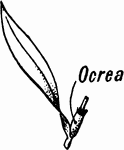
Ocrea
A tubular sheath present on the stem just above the base of the leaves of docks and smartweeds. It is…
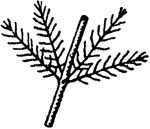
Whorl
An arrangement of leaves or other parts in which they cme off several at the same level around the stem.
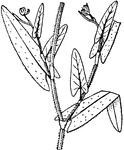
Polygonum
Sheaths around stem above each point of leaf-attachment; flowers white to red, not fragrant.

Pheasant Feather
"Feather from Argus Pheasant. (a,d, main stem; d, calamus; a, rachis; c,c,c, vanes cut away on right…
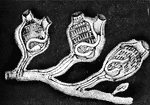
Social Ascidians
"The Clavellinidae, or Social Ascidians, are united by means of a sort of creeping…

Date Palm
"Date Palm is a genus of palms, the most important species of which is the common date palm, the palm…
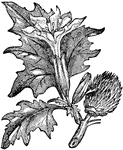
Thorn Apple
"Thorn Apple is a genus of plants. The common thorn apple is an annual plant, with smooth stem and leaves,…
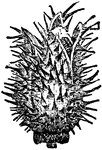
Thorn Apple Bud
"Thorn Apple is a genus of plants. The common thorn apple is an annual plant, with smooth stem and leaves,…

Viper's Bugloss
"Viper's Bugloss is a genus of plants. The species are large herbaceous plants or shrubs, rough with…

Wormwood
"Wormwood is the genus Artemisia. The stem is one to three feet high, grooved, and angled; the leaves…

Yucca
"Yucca is a genus of American plants, natural order Liliaceæ popularly known as Adam's needle.…

Sea-pen
"The main stem of the polypidom of these animals is fleshy, but is furnished with an internal bony axis,…
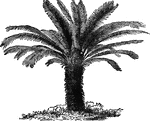
Cycas Revoluta Sago Palm
"Palm is a natural order of endogenous plants, the products of which are of extreme importance and utility…
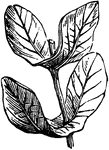
Connate Leaves
A leaf in which the lower lobes are uniteed, either above the stem is sessile or above the petiole if…
